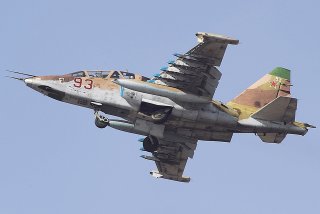Putin's A-10: Why Russia Is Doubling Down on Its Su-25 Frogfoot
Not only has Russia had a lot of experience flying Su-25s in combat—it has shot several down as well.
The Iraqi Air Force has deployed its own Su-25s in the war against ISIS, purchasing five from Russia in 2014 and receiving seven from Iran that had been impounded during the 1991 Gulf War.
Finally, in the fall of 2015, Russia deployed a dozen modernized Su-25SMs in support of the Syrian government of Bashar al-Assad. Many observers noted that of the aircraft involved in the mission, the Su-25s were the best adapted for the close air-support role. The Frogfoot flew 1,600 sorties against rebel-held Syrian cities, and expended more than six thousand munitions, mostly unguided bombs and S-13 rockets. They were withdrawn later in the year, leaving attack helicopter behind to perform more precise—and risky—close air support missions.
Lessons Learned from Flying Tanks?
While it’s fun to admire high-performing fighters like the MiG-29 or F-22 Raptor, the unglamorous Su-25 has so far had a greater impact on a wide range of conflicts. We can draw a few lessons from its recent combat record.
First, the significant losses suffered by Su-25s demonstrate that without effective air-defense suppression and electronic counter-measures, low-and-slow ground support planes are poised to take heavy losses against Russian-made surface-to-air missiles deployed in sufficient numbers.
Second, observation of Russia’s Syrian contingent suggests that despite possessing a diverse arsenal of precision guided munitions, the Russian Air Force continues to rely primarily on unguided bombs and rockets for the close air support mission.
Lastly, aircraft capable of delivering punishing attacks on ground targets while retaining a good chance of surviving hits taken in return are going to remain in high demand worldwide.
Sébastien Roblin holds a Master’s Degree in Conflict Resolution from Georgetown University and served as a university instructor for the Peace Corps in China. He has also worked in education, editing, and refugee resettlement in France and the United States. He currently writes on security and military history for War Is Boring.
This was published in August 2016 and is being reposted due to reader interest.
Image: Wikipedia.

